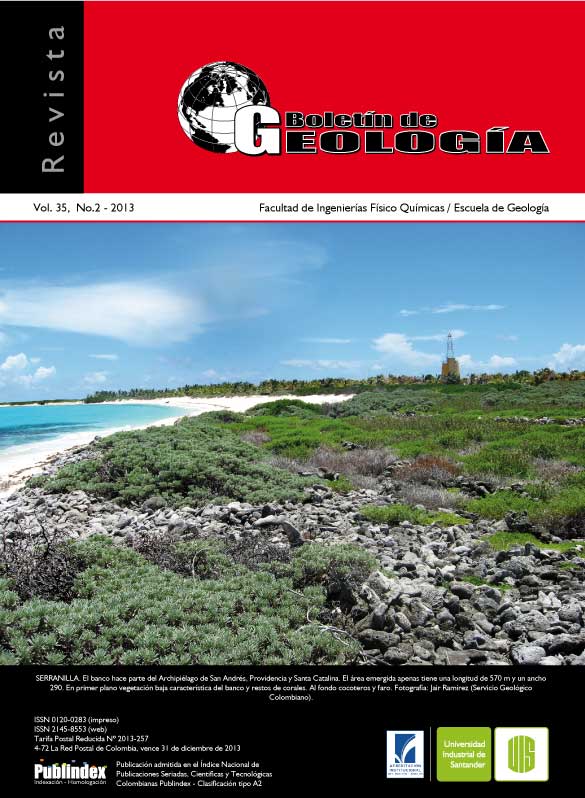GEOCHEMISTRY AND RADIOMETRIC REINTERPRETATION OF THE METABASITES OF THE ARQUIA COMPLEX
Published 2013-12-12
Keywords
- Arquia Complex,
- Age,
- Geochemistry
How to Cite
Abstract
The Arquia Complex appears as a strip elongated, narrow and discontinuous, consisting in amphibole - sericite schist, quartzites and gneisses alongside amphibolites and metagabbros associated with ultramafic rocks. There is located between the Cauca Almaguer and Silvia Pijao Faults, in the collision zone of metamorphic basement of the Cordillera Central and oceanic basement of the Cordillera Occidental of Colombia. The Arquia Complex has been considered as part of a “melange” which is formed for strips thins discontinuous blocks involving continental and oceanic crust parts between Cauca almaguer and San Jerónimo Faults.
Geochemical analysis was performed on Arquia Complex metabasites (Sabaletas schist, Cauca river amphibole schist, Buesaco metamorphic sequence, Bugalagrande Group, Rosario Complex, Bolo azul Complex, Lisboa – Palestina schist and Santa Rosa metagabbro), corresponding to subalkaline tholeiitic basalts protolites type N-MORB with high magnesium, SiO2 between 44,24% and 53,49wt%, alkalis vs SiO2 0,03%- 0,09wt%, with Nb/Y=0,05-0,15 ratios and #Mg=45,03 – 72,34.
The Arquia Complex ages are grouped into the two ranges: 100-113 Ma and 203-229 Ma. The first range (100-113 Ma) corresponded with radiometric ages obtained by K/Ar method, and coincide with the start stage of the Barroso- Sabanalarga Arc, affecting the suture zone and the two crusts, being interpreted as heating ages. The second range include ages between 203 – 229 Ma, obtained by Ar/Ar, and are interpreted as metamorphic age. These data are consistent with the age of metamorphism of the Cajamarca Complex, being this the basement of the Cordillera Central of Colombia.
Downloads
References
Bustamante, A., Juliani, C., Hall, C.M., and Essene, E,J. 2011. 40Ar/39Ar ages from blueschists of the Jambaló región, Central Cordillera of Colombia: Implications on the styles of accretion in the Northern Andes. Geologica Acta, 9 (3-4): 351-362.
Cediel, F., Shaw, R.P., and Cáceres, C. 2003. Tectonic Assembly of the Northern Andean Block. Mexico and the Caribbean region: plate tectonics, basin formation and plate tectonics. C. Bartolini, R. T. Buffler and J.F Blickwede, American Association of Petroleum Geologist, memoir 79: 815-848.
Correa, A.M., Pimentel, M., Restrepo, J.J., Nilson, A., Ordoñez, O., Martens, U., Laux, J.E., and Junges, S. 2006. U-Pb zircón ages and Nd-Sr isotopes of the Altavista Stock and the San Diego Gabbro – new insights on Cretaceous arc magmaism in the Colombian Andes [abs.]: V Simposio Sudamericano de Geología Isotópica 24 - 27 abril 2006, Punta del Este – Uruguay
Dorado, C.E. 2006. Petrografía y geoquímica del complejo Arquía al W de la ciudad de Manizales entre los sectores de la hacienda El Algarrobo y el río Chinchiná. Tesis de Pregrado, Universidad de Caldas, 75p
Estrada, J.J., y Viana, R.G.H. 2001. Geología de la plancha 205 Chinchiná, escala 1:10000: Memoria explicativa. INGEOMINAS, Bogotá, 87p.
Esquivel, J., Florez, D.J., y Núñez, A. 1981. Anfibolitas Granatíferas, Esquistos Anfibólicos y Rocas Máficas y Ultramáficas al Este de Buga-Palmira, Valle. Colombia.- Resúmenes Tercer Congreso Colombiano de Geología, pp. 40-41, Medellín.
Giraldo, M.I. 2010. Esquema geodinámico de la parte noroccidental de la Cordillera Central de Colombia. Facultad de Minas. Medellín, Universidad Nacional de Colombia. Maestría en Ingeniería, Materiales y Procesos: 146p
Gómez, A. de J., Ossa, C.A., y Toro, L.M. 2004. Geoquímica de las rocas del Stock Chinchiná – Santa Rosa. Boletín de Geología, UIS, 26 (42): 67 – 78
González, H. 1978. El Melange de Romeral y sus implicaciones tectónicas en la evolución de la cordillera Central, de los Andes Colombianos. II congreso Colombiano de Geología. Resúmenes, 14p
González, H. 1980. Geología de las planchas 167 (Sonsón) y 187 (Salamina) del Mapa Geológico de Colombia. INGEOMINAS, Boletín Geológico, 23 (1):1-174.
